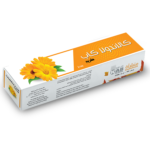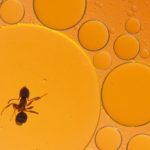Pharmacological Review on Centella asiatica: A Potential Herbal Cure-all
KA.SANTA
MECHANISMS OF ACTIONS BASED ON PRECLINICAL STUDIES
Wound healing:
The CA extracts (CAE) have been used traditionally for wound healing and the research has been increasingly supportive for these claims[8]. A preclinical study reported that various formulations (ointment, cream, and gel) of an aqueous CAE applied to open wounds in rats (3 times daily for 24 days) resulted in increased cellular proliferation and collagen synthesis at the wound site, as shown by an increase in collagen content and tensile strength[17]. The authors found that the CAE-treated wounds epithelialized faster and the rate of wound contraction was higher when compared to the untreated control wounds. Healing was more prominent with the gel product. It is believed to have an effect on keratinization, which aids in thickening skin in areas of infection[18]. Asiaticoside, a constituent in CA, has been reported to possess wound healing activity by increasing collagen formation and angiogenesis[19,20]. Apart from showing a stimulation of the collagen synthesis in different cell types, the asiaticoside were shown to increase the tensile strength of the newly formed skin, furthering the healing of the wounds. Also, it was shown to inhibit the inflammatory process which may provoke hypertrophy in scars and improves the capillary permeability[19,20]. In one laboratory animal study, the effects of asiaticoside on antioxidant levels were examined, as antioxidants have been reported to play a role in the wound healing process[21]. The authors concluded that asiaticosides may have enhanced the induction of antioxidants at an initial stage of wound healing, but continued application of the preparation seemed not to increase the antioxidant levels in wound healing. The activity of asiaticoside has been studied in normal as well as delayed-type wound healing[22]. In guinea pig punch wounds topical applications of 0.2% solution of asiaticoside produced 56% increase in hydroxyproline, 57% increase in tensile strength, increased collagen content and better epithelisation. In streptozotocin diabetic rats, where healing is delayed, topical application of 0.4% solution of asiaticoside over punch wounds increased hydroxyproline content, tensile strength, collagen content and epithelisation thereby facilitating the healing. Asiaticoside was active by the oral route also at 1 mg/kg dose in the guinea pig punch wound model. It promoted angiogenesis in the chick chorioallantoic membrane model at 40 μ/disk concentration. In one study, effects of oral and topical administration of an alcoholic extract of CA on rat dermal wound healing were evaluated[22]. The extract increased cellular proliferation and collagen synthesis at the wound site, as evidenced by increase in DNA, protein and collagen content of granulation tissues. Quicker and better maturation and cross linking of collagen was observed in the extract-treated rats, as indicated by the high stability of acid-soluble collagen and increase in aldehyde content and tensile strength. The extract treated wounds were found to epithelialize faster and the rate of wound contraction was higher, as compared to control wounds. These results indicated that CA produced different actions on the various phases of wound repair by exhibiting significant wound healing activity in normal as well as delayed healing models[23].
Venous insufficiency:
One of primary effects of CA was postulated to be on connective tissues by strengthening the weakened veins[24]. It was postulated that CA might assist in the maintenance of connective tissue[25]. In the treatment of scleroderma, it might also assist in stabilizing connective tissue growth, reducing its formation as it reportedly stimulated the formation of hyaluronidase and chondroitin sulfate, as well as exerted a balancing effect on the connective tissue[25]. CA was reported to act on the connective tissues of the vascular wall, being effective in hypertensive microangiopathy and venous insufficiency and decreasing capillary filtration rate by improving microcirculatory parameters[26]
Sedative and anxiolytic properties:
CA was described to possess CNS effects in Indian literature such as stimulatory-nervine tonic, rejuvenant, sedative, tranquilizer and intelligence promoting property[27]. It has been traditionally used as a sedative agent in many Eastern cultures; the effect was postulated mainly due to the brahmoside and brahminoside constituents, while the anxiolytic activity is considered to be, in part due to binding to cholecystokinin receptors (CCKB), a group of G protein coupled receptors which bind the peptide hormones cholesystokinin (CCK) or gastrin and were thought to play a potential role in modulation of anxiety, nociception, memory and hunger in animals and humans[28]
Antinociceptive and antiinflammatory properties:
The effects of CA upon pain (antinociception) and inflammation in rodent models were reported[49]. The antinociceptive activity of the aqueous CAE (10, 30, 100 and 300 mg/kg) was studied using acetic acid-induced writhing and hot-plate method in mice[49], while the antiinflammatory activity of CA was studied by prostaglandin E2-induced paw edema in rats[49]. The aqueous CAE revealed significant antinociceptive activity with both the models similar to aspirin but less potent than morphine and significant antiinflammatory activity comparable to mefenamic acid. These results suggested that the aqueous CA extracts possesses antinociceptive and antiinflammatory activities which justified the traditional use of this plant in the treatment of inflammatory conditions or rheumatism[50]. Recently, antirheumatoid arthritic effect of madecassoside in type II collagen-induced arthritis (CIA) in mice was studied to investigate the therapeutic potential and underlying mechanisms of madecassoside on CIA[51]. Madecassoside (10, 20 and 40 mg/kg), orally administered from the day of the antigen challenge for 20 consecutive days, dose-dependently alleviated the severity of the disease based on the reduced clinical scores, and elevated the body weights of mice. Also, a histopathological examination indicated that madecassoside alleviated infiltration of inflammatory cells and synovial hyperplasia as well as provided protection against joint destruction. Moreover, madecassoside reduced the serum level of antiCII IgG, suppressed the delayed type hypersensitivity against CII and moderately suppress CII-stimulated proliferation of lymphocytes from popliteal lymph nodes in CIA mice. In vitro, madecassoside was proved to be ineffective in the activation of macrophages caused by lipopolysaccharide[51]. It was concluded in the study that madecassoside substantially prevented mouse CIA, and might be the major active constituent of CA responsible for its clinical uses in rheumatoid arthritis and that the underlying mechanisms of action may be mainly through regulating the abnormal humoral and
cellular immunity as well as protecting from joint destruction[51].
8. Brinkhaus B, Lindner M, Schuppan D, Hahn EG. Chemical, pharmacological and clinical profile of the East Asian medical plant Centella asiatica. Phytomedicine. 2000;7:427–48. [PubMed] [Google Scholar]
17. Sunilkumar , Parameshwaraiah S, Shivakumar HG. Evaluation of topical formulations of aqueous extract of Centella asiatica on open wounds in rats. Indian J Exp Biol. 1998;36:569–72. [PubMed] [Google Scholar]
18. Poizot A, Dumez D. Modification of the kinetics of healing after iterative exeresis in the rat. Action of a triterpenoid and its derivatives on the duration of healing. C R Acad Sci Hebd Seances Acad Sci D. 1978;286:789–92. [PubMed] [Google Scholar]
19. Rosen H, Blumenthal A, McCallum J. Effect of asiaticoside on wound healing in the rat. Proc Soc Exp Biol Med. 1967;125:279–80. [PubMed] [Google Scholar]
20. Incandela L, Cesarone MR, Cacchio M, De Sanctis MT, Santavenere C, D’Auro MG, et al. Total triterpenic fraction of Centella asiatica in chronic venous insufficiency and in high-perfusion microangiopathy. Angiology. 2001;52:S9–13. [PubMed] [Google Scholar]
21. Shukla A, Rasik AM, Dhawan BN. Asiaticoside-induced elevation of antioxidant levels in healing wounds. Phytother Res. 1999;13:50–4. [PubMed] [Google Scholar]
22. Suguna L, Sivakumar P, Chandrakasan G. Effects of Centella asiatica extract on dermal wound healing in rats. Indian J Exp Biol. 1996;34:1208–11. [PubMed] [Google Scholar]
23. Shukla A, Rasik AM, Jain GK, Shankar R, Kulshrestha DK, Dhawan BN. In vitro and in vivo wound healing activity of asiaticoside isolated from Centella asiatica. J Ethnopharmacol. 1999;65:1–11. [PubMed] [Google Scholar]
24. Allegra C. Comparative Capillaroscopic study of certain bioflavonoids and total triterpenic fractions of Centella asiatica in venous insufficiency. Clin Ther. 1981;99:507–13. [PubMed] [Google Scholar]
25. Darnis F, Orcel L, de Saint-Maur PP, Mamou P. Use of a titrated extract of Centella asiatica in chronic hepatic disorders. Sem Hop. 1979;55:1749–50. [PubMed] [Google Scholar]
26. Cesarone MR, Laurora G, De Sanctis MT, Belcaro G. Activity of Centella asiatica in venous insufficiency. Minerva Cardioangiol. 1992;40:137–43. [PubMed] [Google Scholar]
49. Somchit MN, Sulaiman MR, Zuraini A, Samsuddin LN, Somchit N, Israf DA, et al. Antinociceptive and antiinflammatory effects of Centella asiatica. Indian J Pharmacol. 2004;36:377–80. [Google Scholar]
50. Newall CA, Anderson LA, Phillipson JD. Hydrocotyle. Herbal Medicines A Guide for Health Care Professionals. London: The Pharmaceutical Press; 1996. pp. 170–72. [Google Scholar]
51. Liu M, Dai Y, Yao X, Li Y, Luo Y, Xia Y, et al. Anti-rheumatoid arthritic effect of madecassoside on type II collagen-induced arthritis in mice. Int Immunopharmacol. 2008;8:1561–6. [PubMed] [Google Scholar
 Previous Post
Previous Post Next Post
Next Post